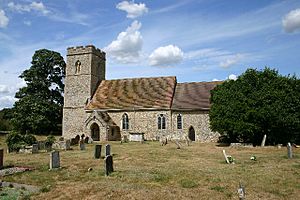St Andrew's Church, Sapiston facts for kids
Quick facts for kids St Andrew's Church, Sapiston |
|
|---|---|

St Andrew's Church, Sapiston, from the south
|
|
| Lua error in Module:Location_map at line 420: attempt to index field 'wikibase' (a nil value). | |
| OS grid reference | TL 921 743 |
| Location | Sapiston, Suffolk |
| Country | England |
| Denomination | Anglican |
| Website | Churches Conservation Trust |
| Architecture | |
| Functional status | Redundant |
| Heritage designation | Grade I |
| Designated | 14 July 1955 |
| Architectural type | Church |
| Style | Norman, Gothic |
| Specifications | |
| Materials | Flint, with some ragstone Tiled roofs |
St Andrew's Church is a very old church in the village of Sapiston, Suffolk, England. It's an Anglican church, but it's now a "redundant church," which means it's no longer used for regular services. However, it's kept safe because it's a special historic building.
The church is listed as a Grade I building, which means it's considered extremely important and is protected. The Churches Conservation Trust looks after it. You can find St Andrew's Church down a quiet path, close to a farm and a small stream called Black Bourne. This church once served a village that is now gone, a "deserted medieval village."
Contents
History of St Andrew's Church
The oldest part of St Andrew's Church is its south doorway, which was built way back in the 1100s during the Norman times. Most of the rest of the church, like the main hall (called the nave), the altar area (called the chancel), and the tower, were built later in the 1300s.
The church was repaired and updated in 1847. This kind of work is called a "Victorian restoration" because it happened during Queen Victoria's reign. In 1972, the church's area (called a parish) joined with a nearby village called Honington. Two years later, in 1974, St Andrew's Church was declared redundant. It was then given to the Redundant Churches Fund, which is now known as the Churches Conservation Trust.
Church Architecture and Design
Outside the Church
St Andrew's Church is built mostly from flint stones, with some ragstone too. Its roofs are steeply sloped and covered with tiles. The church has a main hall (nave) with a porch on the south side, an altar area (chancel), and a tower on the west side.
The tower has three levels, separated by stone lines called string courses. It doesn't have buttresses (supports) on the outside. Inside the tower, there's a staircase, and at the top, it has a battlement (a wall with gaps for defense). The top level has two-light openings for bells, with stone patterns called Y-tracery.
The south porch was added in the 1400s. It has a simple doorway and two two-light windows on each side. The floor of the porch is made from old medieval coffin lids, which is quite unique! The main south doorway has two sets of columns and three curved arches. The inner arch is plain, but the outer two arches are decorated with acanthus leaves. This is an unusual design for churches in Suffolk. Above the arch, there's a weathered stone carving of a face, probably a human one.
Along the south wall of the church, there are two windows with Y-tracery and another window with a Tudor arch. In the south wall of the chancel, there's a single window and a doorway with a pointed arch. The large east window has three lights and a net-like stone pattern called reticulated tracery.
Inside the Church
Inside St Andrew's Church, on the north wall of the nave, you can see the remains of an Easter Sepulchre. This was an arched space used during Easter celebrations. Above it, there are faint traces of a wall painting. This painting shows the story of Saint Edmund being killed.
Around the walls, there are old wooden benches. Two of these benches are smaller with lower seats, which were probably made for children. The font, where baptisms take place, is octagonal (eight-sided) and dates from the 1200s. It's quite plain and has a damaged cover from the Jacobean period.
In the chancel, there's a piscina (a basin for washing sacred vessels) with an ogee head (a special S-shaped curve). There's also a window in the south wall that has been blocked up. The church has a memorial dedicated to the local poet Robert Bloomfield. You can also see the royal arms of King George II inside. The church once had four bells, but they have been taken down. Three of them were made in 1591, 1608, and 1730.
See also

